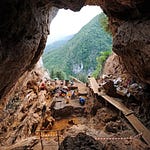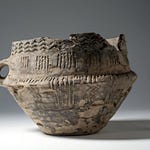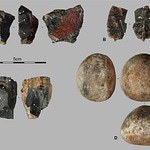A Palace on the Edge of an Empire
In the foothills of modern-day Tajikistan, 12 kilometers east of Panjikent, archaeologists have been piecing together a royal residence once at the heart of the Sogdian world. Known today as Sanjar-Shah, the palace belonged to a society that thrived as city-states along the arteries of the Silk Road. The Sogdians — merchants, colonists, and civic innovators — linked China, India, and Persia, trading not only goods but also religious and artistic traditions.
Constructed in the 5th century AD and later expanded under the Umayyads, the palace at Sanjar-Shah mirrored other Sogdian complexes: reception halls arranged around a T-shaped corridor, Chinese mirrors, and imported belt buckles hinting at elite status and far-reaching connections. Destroyed by fire in the third quarter of the 8th century, the palace was later subdivided by peasants during the early Samanid period.
Murals of a Lost Religion
Among the debris, archaeologists have uncovered fragments of once-monumental murals. Scenes of blue lotus flowers and hunting parties echo the decorative style of Panjikent’s famed wall paintings. But in 2022–2023, researchers recovered something different — 30 fragments forming a procession of four priests and a child moving toward a stationary fire altar.
“The first priest is seen kneeling before the fire altar, offering up a smaller altar to the larger one,” notes Dr. Michael Shenkar, lead author of the study published in Antiquity1. This act mirrors familiar gestures in Sogdian art, where worshipers present incense to sacred flames.
Such depictions are almost exclusively known from funerary ossuaries — and normally only show two priests, not four. This makes the Sanjar-Shah mural unique.
Sacred Fire and Ritual Attire
The mural also preserves an extraordinary detail of ritual costume. One priest wears a padām — a mouth covering still used by Zoroastrian priests today — meant to prevent human breath from polluting the sacred flame.
“It is a ritual mouth covering worn by priests to prevent their breath from polluting the sacred fire during religious ceremonies,” Shenkar explains.
Another priest features a puzzling ribbon tied at the back of his neck — a motif more often associated with divine or royal figures.
“At present, I am unable to provide a satisfactory explanation for the presence of the ribbon on the second priest figure. As this motif is conventionally associated with divine or royal imagery, its occurrence in this context remains problematic,” Shenkar adds.
Fire in the Sogdian Imagination
The discovery at Sanjar-Shah illuminates how Zoroastrian fire worship adapted in a Silk Road context. The Sogdians, predominantly Iranian-speaking and practicing forms of Zoroastrianism, were famous for their artistic synthesis of Persian, Indian, and Central Asian motifs. Yet direct depictions of ritual fire within palatial contexts — rather than funerary ones — have been exceedingly rare.
By situating sacred fire at the heart of a royal palace, the mural suggests that fire cults may have been woven into elite ceremonial life. It also demonstrates how religious and political authority could overlap — the palace as a stage for ritual as much as for governance.
A Vanished World
By the late 8th century, Sanjar-Shah’s palace was destroyed and its murals buried beneath rubble. The rise of Islam and the decline of Sogdian city-states shifted the region’s religious landscape. Yet in these fragments — priests frozen mid-procession, the sacred flame steady at center stage — a world of ritual and belief flickers to life again.
Related Research
Grenet, F. (2015). Zoroastrianism on the Silk Road. Bulletin of the Asia Institute, 25, 1–18.
Shenkar, M. (2019). Intangible fire: Sogdian religious iconography in its historical context. Iranica Antiqua, 54, 193–215. https://doi.org/10.2143/IA.54.0.3285044
Canepa, M. P. (2018). The Iranian Expanse: Transforming Royal Identity Through Architecture, Landscape, and the Built Environment, 550 BCE–642 CE. University of California Press.
Marshak, B. I. (2002). Legends, Tales, and Fables in the Art of Sogdiana. Markus Wiener Publishers.
Shenkar, M., Kurbanov, S., & Pulotov, A. (2025). A unique scene of fire worship from the late Sogdian palace at Sanjar-Shah. Antiquity, 1–7. https://doi.org/10.15184/aqy.2025.10180










